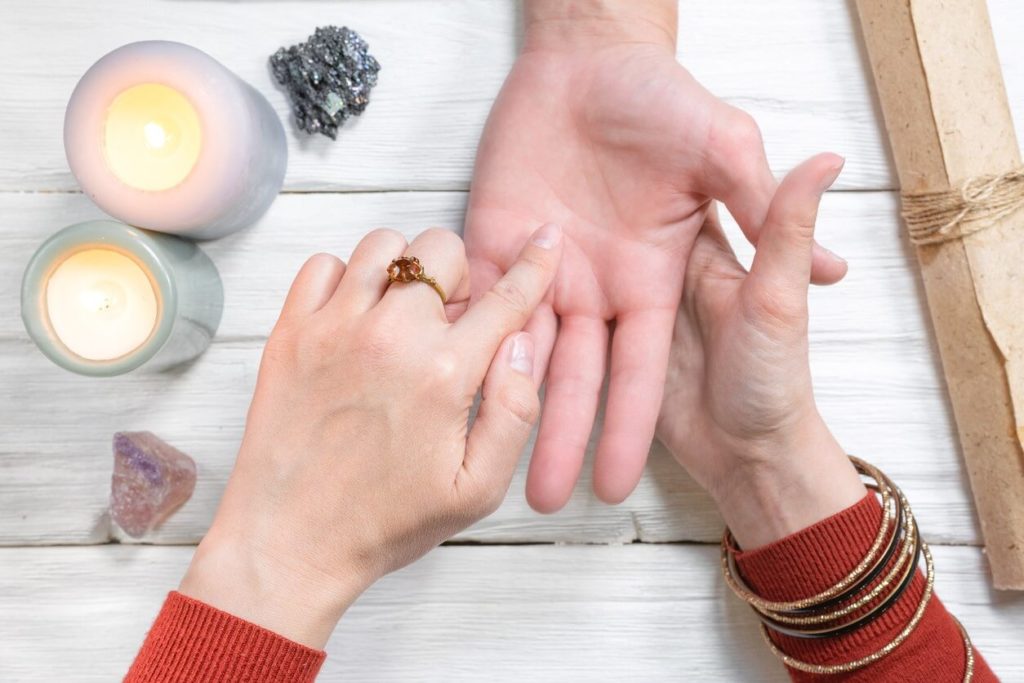Palmistry: interpretation of the lines of the hand?
Written by: Loris Vitry (holistic coach)
Validated by: Cathy Maillot (Osteopath)
Caution: If you have any medical questions or concerns, please speak to your doctor. Even if the articles on this site are based on scientific studies, they do not replace professional medical advice, diagnosis or treatment.

Palmistry is an extremely ancient divination art of predicting the future from the lines of the hand.
Although governed by several rules and codes, this practice remains more mystical than scientific.
The word palmistry is said to be derived from the combination of the words “Kheir” from ancient Greek meaning “hand” and “mantela” meaning “divination”.
To know everything about palmistry, just read the rest of this article.
Origin and history of palmistry
The origins of palmistry are difficult to determine exactly.
One theory would attribute its origin to ancient Egypt during the time of Pharaoh Ptolemy.
According to other sources, although the Greek philosopher Aristotle spoke about it in his treatises, palmistry would originate in Asia and more precisely in India.
It is thus estimated that from India it would have reached China, where it would have been deepened.
It would thus have become more than a divinatory art, it is a medicine.
The Chinese are said to have found a way to heal the human organism through the nerve endings of the hands.
Whatever its origin, divinatory palmistry knew its greatest popularity in the Middle Ages.
The interpretation of the lines of the hand is then practiced in secret, because it is prohibited by the Church.
Palmistry is one of the least practiced divination arts today.
Reading the Tarot is often preferred to him.
However, many agree that palmistry offers more personalized answers than Tarot since the lines of the hand are unique to each individual.
While palmistry is usually thought of as interpreting the lines of a hand, it actually turns out to be much more.
For a palmistry session, the lines of the hand are not enough, you must also know the type of hand.
Hand types and hand lines
There are four types of hands in palmistry, and each is associated with one of the four western elements: air, fire, earth, and water.
The air hand
Square palm, long, bony fingers – these are the hallmarks of the air hand.
This type is often attributed to intellectuals.
It is the hand of researchers, journalists or writers.
The planet attributed to it is Venus.
The earth hand
She is rather square, with short fingers.
It is attributed to practical people who often have trades as farmers or mechanics.
It is associated with the planet Mars.
The water hand
Thin with long fingers, this hand is that of the sensitive and the intuitive.
Those with a wet hand often have professions such as writers or doctors.
Venus or the moon is associated with it.
Hand of fire
Plump, it has short fingers and a rectangular palm.
It is attributed to enthusiasts.
Here, we find risky professions such as that of firefighter, but also those who like to pass on their knowledge with fever.
Their planet is Jupiter.
Sometimes it is necessary to shake a person’s hand, to know if it is dry or wet in order to determine its category.
You must also take into account the mountains during a palmistry session.
Mounts are the protuberances found below each finger.
They provide information about an individual’s personality.
Regarding the lines of the hand, it is believed that the left hand would show our potential and the right the way we use it.
There are three main lines in palmistry.
These are the longest and most marked lines.
There’s the heart line, the head line, and the life line.
The heart line
It is found on the upper part of the palm of the hand.
It crosses the palm of the hand horizontally and crosses it.
Through this line, we can give an interpretation of a person’s love life.
So while it is deep and long, the heart line is a sign of a long and beautiful love story.
The head line
Horizontal, this line is found below the heart line.
She can get stuck to the lifeline.
The head line gives information about how we think and function.
A straight headline conveys a Cartesian personality, while if it is more curved, we are dealing with a more creative mind.
The Line of Life
It is usually considered the most important of the lines of the hand.
She is the one who talks about our lives retracing the most significant events.
It begins between the thumb and forefinger and ends at Mount Venus, the roundness found under the thumb.
The length of the lifeline is not to be associated with the length of a lifetime, it determines the general physical condition.
If it is cut by segments, then these would testify to difficult times.
Apart from these three main lines, there are also minor lines, like the line of Fate.
For a good palmistry session, it is important to take this into account.
How to practice palmistry?
Once you have identified the type of hand, the lines of the hand and the different mounts, you can start your session.
The interpretation of the lines of the hand is always done on the dominant hand, the active hand.
On this hand, you have to study the main lines.
To do this, we must pay close attention to the segments that can cut them, because they are representative of often important events.
Then study the shape of the mountains very carefully.
To complete your reading, feel free to palpate your fingers, to touch the palm to know if it is dry or wet.
Ask questions to get a feel for what drives the person, to get specifics about things you might have read on their hand.
A good palmistry session leaves no detail to chance.
Palmistry is not a science.
It is not based on any scientific data and its results cannot be demonstrated empirically.
It is closer to astrology and fortune telling.
Although it suffers from many charlatans, it is an ancient art that has survived time.
Perhaps we will benefit from putting a little mysticism in our modern lives in order to decrease the resulting stress.
Continue reading:
Well-being coaching: how to become a health coach?

